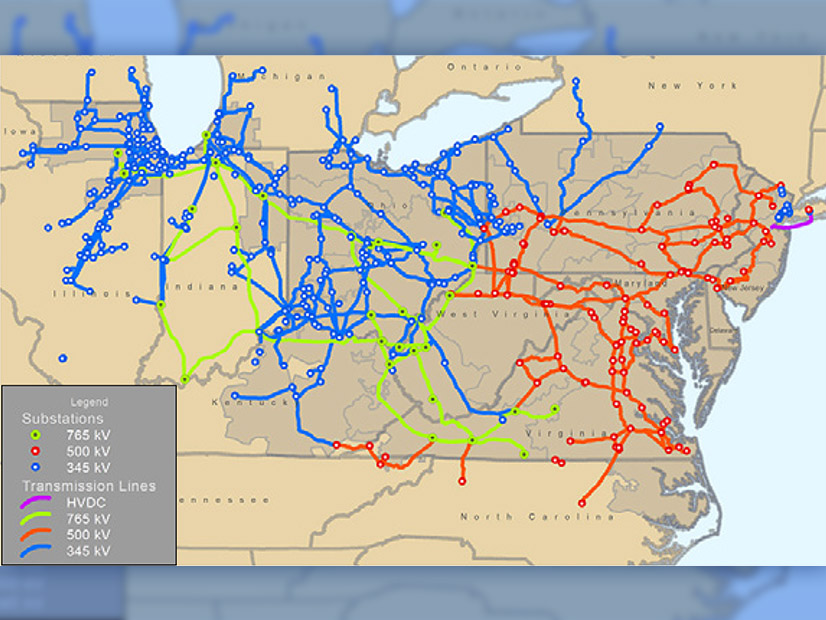PJM saw interconnection requests for solar generation more than triple since 2019, now making up more than half the interconnection queue, according to the 2021 Regional Transmission Expansion Plan (RTEP) report released Tuesday.
The annual report highlighting transmission projects approved last year by the PJM Board of Managers features several trends, including the continuing shift in the RTO’s generation mix driven by new natural gas-fired plants, the deactivation of coal-fired plants and the increasing volume of renewable generation.
PJM processed 1,351 new service requests in 2021, nearly triple the 476 requests made in 2018. The new service requests totaled 104,316 MW of nameplate capacity in 2021.
A total of 139,937 MW of generation interconnection requests was actively studied by PJM last year, a number nearly equal to the RTO’s all-time winter peak of 143,295 MW set on Feb. 20, 2015.
On the renewable energy front, solar generation currently makes up 58% of the interconnection queue, a total of 94,000 MW of the 160,000 MW of resources in the queue. In the 2019 RTEP, solar requests stood at 47% of the 75,432 MW in the queue.
“Previously, solar projects were smaller in size and limited to a handful of areas,” the report said. “Now, individual projects can reach hundreds of megawatts, driven by states’ renewable portfolio standards goals, and are seeking interconnection in every PJM transmission zone.”
Project Numbers
The PJM board approved a total of $920 million among 118 baseline transmission projects in 2021.

Of the projects, 52% ($478 million) of them were driven by transmission owner criteria, 25% ($229 million) by PJM and NERC criteria and 23% ($213 million) by 52 generator deactivations or retirements.
PJM noted that large-scale transmission projects above 345 kV remain “uncommon” in the RTO, as load growth fell below 1% to a normalized 10-year RTO summer peak growth rate of 0.6%. The average 10-year-annualized summer growth rates for individual PJM zones ranged from -0.5% to 1.5%.
“Load forecasts from the past five years reflect broader trends in the U.S. economy and PJM model refinements to capture evolving customer behaviors,” PJM said in its report. “These include more efficient manufacturing equipment and home appliances and distributed energy resources, such as behind-the-meter, rooftop solar installations.”
PJM said the projects approved in 2021 responded to “diverse needs” such as upgrades and replacement of aging equipment and facilities to meet reliability and resilience criteria, the “minimization” of system congestion for market efficiency, localized reliability needs and generator deactivations.
In preparation for new generation resources coming onto the grid, the board also approved 34 network system enhancement projects totaling more than $47 million. The board has approved network facility reinforcements totaling more than $6.5 billion since the inception of the RTEP process in 1997.
Offshore Wind
With the growing number of offshore wind projects coming into the interconnection queue, PJM said the injection of thousands of megawatts of power will change how power flows across the grid in the Northeast and Mid-Atlantic. PJM said “efficiently harnessing” the new power source is going to require extending the existing transmission grid to offshore generation sources and deliver their energy to load centers along the East Coast.
Maryland, New Jersey and Virginia have established offshore wind targets totaling 14,723 MW with planned in-service dates of 2035.
In 2021, PJM planned for the offshore wind transmission expansion, partnering with NYISO and ISO-NE with the goal of achieving 30 GW of operational offshore wind by 2030. The RTO also worked with New Jersey under the “state agreement” approach to help identify the most efficient and economic solutions to accommodate offshore wind.
“Although offshore wind is on a longer planning horizon, the potential for development is substantial,” PJM said in the report. “Future system enhancements will solve the challenges that these locationally constrained resources present. Moreover, they will also address the interregional implications associated with wind lease areas that can also serve adjoining systems north and south of PJM’s RTO borders.”



